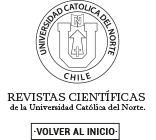Acerca de la cerámica Tiwanaku y una vasija del valle de Azapa (Arica, Norte Grande de Chile)
Keywords:
expansión Tiwanaku, "Señor de los Cetros", valle de Azapa, alfarería, estilo, Tiwanaku expansion, "Lord of the Scepters", valley of Azapa, pottery, style.Abstract
La intención de este artículo ha sido contribuir a la comprensión de la problemática Tiwanaku en Arica, usando como "excusa" el redescubrimiento de una vasija excepcional, proveniente del sitio funerario Az-71a del valle de Azapa excavado por G. Focacci. Lo significativo de la vasija es que la pintura reproduce no sólo la imagen, sino también el antiquísimo tema del "Señor de los Cetros", cuya manifestación es prácticamente inexistente en la alfarería y más bien privativa de la escultura lítica del altiplano. De hecho, esta sería la única manifestación de aquello elaborado en dicho soporte dentro de toda la órbita de distribución de los materiales altiplánicos conocidos hasta ahora. De todo ello deriva la exclusividad de la pieza y, por lo mismo, la usamos para reflexionar sobre la denominada "expansión Tiwanaku", específicamente hacia los Valles Occidentales del Area Centro Sur Andina. En función de lo anterior revisamos y registramos las colecciones cerámicas y su iconografía, en especial, aquellas piezas de la periferia de la esfera de interacción del Estado altiplánico, centrándonos en el valle de Azapa
Abstract
This paper aims to contribute to the understanding of the Tiwanaku problem in Arica (Northern Chile), with the "excuse" of the rediscovery of an exceptional vessel that was excavated by G. Focacci in the funerary site Az-71a (valley of Azapa). Most significantly, this painted piece represents the antique image of the "Lord of the Scepters", topic that has not shown up in Tiwanaku pottery, but more typically, in stone sculptures from the altiplano. It would be, in fact, the only object of this sort so far known for the entire altiplano sphere of distribution. The uniqueness of this piece leads us to reflect on the so-called "Tiwanaku Expansion", and more specifically at that which would have taken place in the Westerns Valleys region of the South-Central Andes area. We reviewed and registered existing ceramic collections and their iconography with this in mind, putting particular attention to those pieces found in the peripheries of the Titicaca State, and with a special focus on those found in the valley of Azapa
Downloads
Downloads
Published
Issue
Section
License

All works published in Revista Estudios Atacameños (ISSN on line:0718-1043) Revista Estudios Atacameños Creative Commons International 4.0 attribution (CC BY 4.0) licence.
Authors remain the owners of their work and may republish their articles elsewhere without having to request permission, as long as they indicate that the work was originally published in Revista Estudios Atacameños (ISSN on liine:0718-1043).












